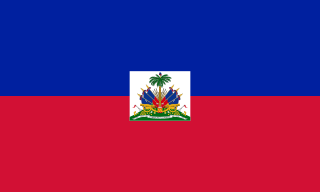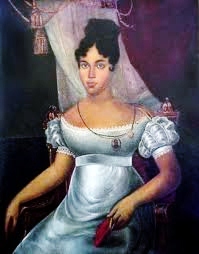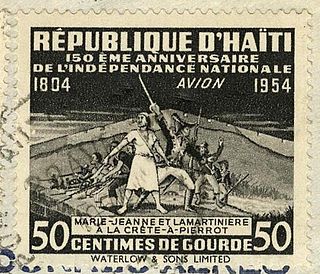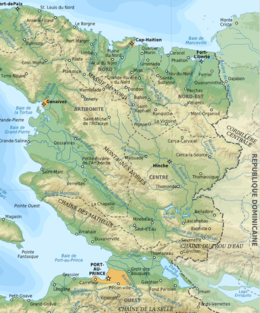
Haiti, officially the Republic of Haiti formerly founded as Hayti, is a country located on the island of Hispaniola in the Greater Antilles archipelago of the Caribbean Sea, to the east of Cuba and Jamaica and south of The Bahamas and the Turks and Caicos Islands. It occupies the western three-eighths of the island which it shares with the Dominican Republic. To its south-west lies the small island of Navassa Island, which is claimed by Haiti but is disputed as a United States territory under federal administration. Haiti is 27,750 square kilometers (10,714 sq mi) in size and has an estimated population of 11.1 million, making it the most populous country in the Caribbean Community (CARICOM) and the second-most populous country in the Caribbean after Cuba.

The Republic of Haiti comprises the western three-eighths of the island of Hispaniola, west of the Dominican Republic. Haiti is positioned east of the neighboring island of Cuba, between the Caribbean Sea and the North Atlantic Ocean. Haiti's geographic coordinates are at a longitude of 72° 25′ west and a latitude of 19° 00′ north.

Cap-Haïtien, often referred to as Le Cap or Au Cap, is a commune of about 190,000 people on the north coast of Haiti and capital of the department of Nord. Previously named Cap‑Français and Cap‑Henri, it was historically nicknamed the Paris of the Antilles, because of its wealth and sophistication, expressed through its architecture and artistic life. It was an important city during the colonial period, serving as the capital of the French Colony of Saint-Domingue from the city's formal foundation in 1711 until 1770 when the capital was moved to Port-au-Prince. After the Haitian Revolution, it became the capital of the Kingdom of Northern Haiti under King Henri Christophe until 1820.

Sud-Est is one of the ten departments of Haiti. It has an area of 2,034.10 km2 and a population of 632,601 (2015). Its capital is Jacmel.

Operation Uphold Democracy was a military intervention designed to remove the military regime installed by the 1991 Haitian coup d'état that overthrew the elected President Jean-Bertrand Aristide. The operation was effectively authorized by the 31 July 1994 United Nations Security Council Resolution 940.

Port-de-Paix is a commune and the capital of the Nord-Ouest department of Haiti on the Atlantic coast. It has a population of 462,000. Port-de-Paix used to be a large exporter of bananas and coffee.

Ligue Haïtienne, is a Haitian professional league, governed by the Haitian Football Federation, for association football clubs. It is the country's primary football competition and serves as the top division of the Haitian football league system. Contested by 20 clubs, it operates on a system of promotion and relegation with Division 2.

The Combat Aviation Brigade, 10th Mountain Division is a combat aviation brigade of the United States Army based at Fort Drum, New York. It is a subordinate unit of the 10th Mountain Division.

Les Palmes is a rural settlement in the Léogâne Arrondissement, in the Ouest department of Haiti. There are more than 30,000 people living in the area.

Louisiane Saint Fleurant was a Haitian female artist and painter. She was a founder of the peasant Saint Soleil art movement.
Kervens Fils Belfort is a Haitian international footballer who plays as a striker for Bangladesh Football Premier League side Abahani Limited Dhaka.
Marie Sainte Dédée Bazile, known as Défilée and Défilée-La-Folle, is a figure of the Haitian Revolution. She is remembered for retrieving and burying the mutilated body of Emperor Dessalines after his assassination at Pont Larnage.

Victoria "Abdaraya Toya" Montou was a Dahomey in the Benin tribe and freedom fighter in the army of Jean-Jacques Dessalines during the Haitian Revolution. She was reportedly Dessalines's aunt. Toya was a slave in Henry Duclos estate. Toya Montou was not the only woman to serve in the Haitian army during the revolution. While most of the names of the female soldiers are forgotten, exceptions are Marie-Jeanne Lamartiniére, who served at the Battle of Crête-à-Pierrot, that took place from 4 March until 24 March 1802, and Sanité Belair.

Marie-Madeleine Lachenais, known as Joute, was a de facto Haitian politician. She was the mistress and political advisor of president Alexandre Sabès Pétion and president Jean-Pierre Boyer and exerted a significant influence over the affairs of state during their presidencies, for a period of 36 years (1807–1843). She was called "The President of two Presidents" and regarded to have been the most politically powerful woman in the history of Haiti before the introduction of women’s suffrage in 1950.
Juliette Bussière Laforest-Courtois, was a Haitian teacher and journalist. She co-founded and managed the first school in Haiti opened to girls (1818–1828) and co-managed the paper La Feuille du Commerce where she was active as a journalist (1828–1853). She was the first journalist of her gender in Haiti.

Marie-Jeanne Lamartiniére, known in history only as Marie-Jeanne, was a Haitian soldier, woman of color, and reportedly a "dazzling beauty." She served in the Haitian army during the Haitian Revolution, which was a successful anti-slavery and anti-colonial insurrection by self-liberated slaves against French colonial rule. It took place 1791-1804.

Paulette Poujol-Oriol was a Haitian educator, actress, dramaturge, feminist and writer. Fluent in French, Creole, English, Spanish, German, and Italian, she contributed to Haitian arts and literature, and founded Picolo Teatro, a performing arts school for children. She has been recognized as one of Haiti's leading literary figures as well as one of the most active players in Haiti's feminist movement.
Argentine Bellegarde-Foureau (1842-1901) was a Haitian educator. She was the head of the national network of the girl schools of Haiti, the Pensionnat national des demoiselles, from 1880, and are regarded to have played an important part in the education of girls in Haiti. She was also known as a vocal critic of all abuse from both the liberal and national party, and spoke for solidarity and equal education for sexes as a principle to reform society.
Marie-Rose Léodille Delaunay (1827-1906) was a Haitian educator. She founded the l'Institution Mont-Carmel in 1850 and was its manager until 1903. This was the first secular secondary educational school for girls in Haiti. She founded her school only two years after education of girls had been formally included in the government policy at all, and it was a pioneer institution: since the 1810s, there had been some private basic education schools for girls, but it was not until the 1850s that secondary education schools for girls were founded in Haiti.













